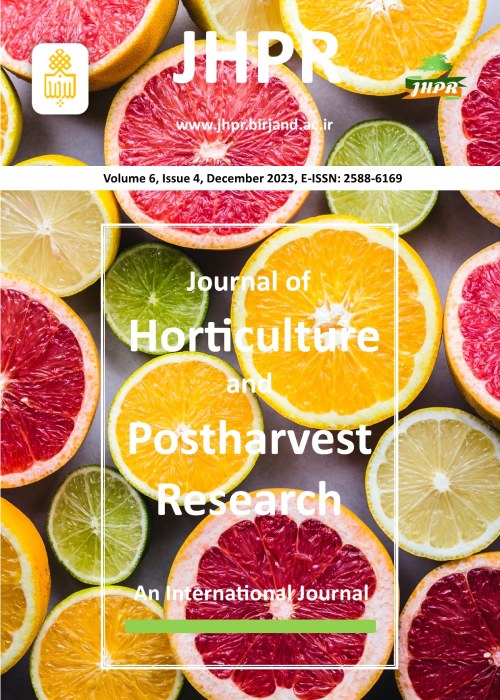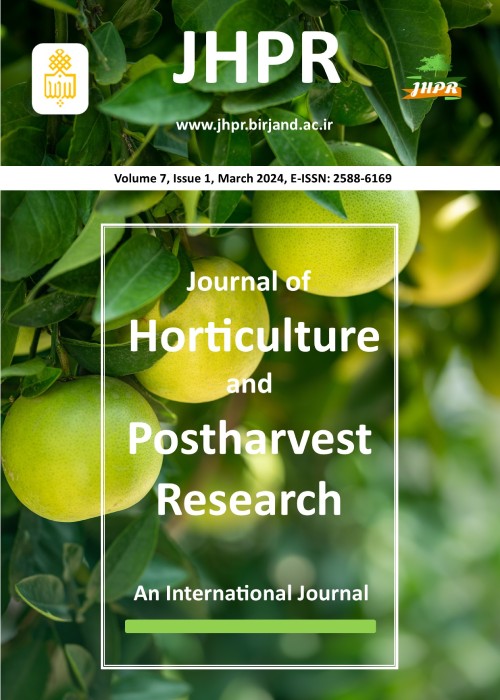فهرست مطالب

Journal of Horticulture and Postharvest Research
Volume:6 Issue: 4, Dec 2023
- تاریخ انتشار: 1402/09/10
- تعداد عناوین: 8
-
-
Pages 331-348Purpose
This research investigated the effect of different regimes of supplementary LED light on physiological and morphological traits of two cultivars of cut Roses.
Research methodIn this study, treatments included cultivars (Allstar and Dolcevita) and nine light regimes including (Control, LED night from 5 pm to 7 am, LED day from 7 am to 5 pm, LED night day (24 hours light) and LED dark (24 hours, without sunlight) which were all applied in two intensities of 2000 and 4000 lux.
FindingsThe results showed that the LED light regime had a positive effect on morphological traits such as the number of buds and mean harvest, length, diameter and fresh weight of flowers. LED day 4000 lux improved bud diameter and mean harvest by 18% and 112% respectively compared with control in Dolcevita cultivar. The light regime also caused a significant improvement in physiological characteristics so that in Allstar cultivar LED day 4000 lux, chlorophyll a, b, total, and carotenoid were increased by 66%, 60%, 63%, and 64% respectively compared with control. The vase life in Allstar cultivar by LED night day 4000 lux intensity and Dolcevita cultivar by LED day 4000 lux were 44.5% and 133.2% higher than the control treatment, respectively.
Research limitations:
There was no limitation.
Originality/Value:
The results showed that LED night day with 4000 lux intensity had the best results in vase life in Allstar cultivar and LED day supplementary light with 4000 lux intensity increased the quantity and quality characteristics of roses.
Keywords: Led, Light intensity, Light quality, Supplementary light, Vase life -
Pages 349-360Purpose
Fungal infections have become the most common problem to cause postharvest loss in tomato enterprise across Nigeria. Morphology-based identification of fungal species usually provides the inconclusive results with several species remain unidentified. Molecular identification method was used to supplement morphology-based techniques to identify the fungal species.
Research MethodA Deoxyribonucleic Acid (DNA) through 5.8S-ITS (Internal Transcribed Spacer) region of the ribosomal DNA (rDNA) was used to identify 180 infested tomato specimens. The samples were collected from farm, retail and wholesale points in Kwanar Gafan located at Kura LGA of Kano State.
FindingsEight haplotypes have been detected from the total fungal specimens examined, A 65.6% of fungal specimens from wholesales and farms constituted haplotype-1 and identified as Pichia kudriavzevii (with 99.54% similarity) as BLAST in National Centre for Biotechnology Information (NCBI) database. The remaining seven haplotypes were exclusively found in the retailing points and largely constitutes Aspergillus spp., Mucor fragilis, Russula atroglauca, Ganoderma sp., Alternaria spp., Exserohilum rostratum, Colletotrichum boninense, Naganishia sp. and Cladosporium spp.
Research limitations:
Further research on molecular identification from other parts of kano is required for better understanding the fungi associated with postharvest loss in the state.
Originality/Value:
Pichia kudriavzevii is a single and only dominant fungal species that infest tomatoes in both farms and wholesale points (65.6%). However, 34.4% of the diverse fungal species have been found in retailing points which is related to the rapid infestation of tomatoes.
Keywords: Haplotypes, Pichia kudriavzevii, Postharvest infestation, Vegetable, Wholesale -
Pages 361-370Purpose
Pistachio is a crusial agricultural product in Iran, but its contamination with various micro-organisms can cause problems in production, consumption, and export. Peracetic acid is an antimicrobial substance that can eliminate a wide range of micro-organisms quickly. This study aimed to evaluate the effectiveness of peracetic acid in reducing microbial contamination of pistachios in processing terminals.
Research methodHarvested pistachios were treated with concentrations of 0 (control), 1, and 2% peracetic acid at the washing basin of the terminal. Then microbial growth, bacterial and fungal population, lipid percentage, and peroxide number of pistachio kernels were evaluated at 0 and 6 months after treatment.
FindingsThe results showed that both 1 and 2% peracetic acid inhibited bacterial and fungal growth by about 100% and reduced microbial flora growth by more than 90%. As there was no significant difference between 1 and 2% peracetic acid, the final recommendation is to use 1% concentration. After 6 months, the contamination level increased by about 5%, possibly due to storage conditions and contamination in subsequent stages. Different concentrations of peracetic acid did not have a significant effect on lipid percentage or peroxide number of pistachio kernels.
Research limitations:
As the treatment time with peracetic acid in the washing basin is uncontrollable, this factor has been eliminated in this research.
Originality/Value:
The study confirms the importance of using peracetic acid in the terminals to reduce and control pistachio contamination without producing harmful by-products. Economic evaluation also showed that using 1% peracetic acid for disinfecting pistachios in processing terminals is cost-effective.
Keywords: Disinfectant, Lipid percentage, Microbial flora, Peroxide value -
Pages 371-382Purpose
CMS hybrid seed production systems are employed effectively for onion. Cytoplasmic male sterility (CMS) has long been used to economically produce hybrids that harness growth vigor through heterosis. Three types of onion CMS (CMS-S, CMS-R, and CMS-T) have been used in hybrid onion breeding.
FindingsThe sources of onion CMS, their maintainer plants and fertility restorer lines can be distinguished by markers, saving times spent on crop establishment and avoiding the complex of phenotypic screening. Numerous molecular markers especially PCR markers associated with male-sterile (CMS-S and CMS-T) cytoplasms, male-fertile normal (N) cytoplasm and nuclear-male- fertility restorers (Ms locus) were developed. These simple PCR markers are valuable tools for the marker-assisted selection of segregating individuals in onion F1 hybrid breeding programs. The present review reveals practical utility and functional effectiveness in the MAS of male-sterile cytoplasm types with nuclear-fertility-restorer locus.
Limitations:
the environment effect especially temperature may cause male-sterility instability and deviations in segregation ratios for male sterility. Also, maximum exploitation of molecular markers linked to Ms/ms and CMS-S, -T genes aid in the recovery of male-sterile traits requires to a perfect linkage disequilibrium that must be investigated further.
Directions for future research:
Furthermore, this information could highly have paved the way for hybrid onion development by applicating of the molecular findings to identify onion male sterility, maintainer and male fertility restorer lines.
Keywords: Allium cepa, Cytoplasmic genetic male sterility, Hybrids, PCR marker, Restorer lines -
Pages 383-396Purpose
To investigate the effects of Putrescine and Indole-3-Butyric Acid (IBA) on the adventitious rooting of micro-cuttings and semi-hardwood cutting of Rosa damascena, this study was conducted under both in vitro and in vivo conditions. Research
MethodThe rooting of micro-cuttings was induced on the basal MS medium supplemented with five concentrations (0, 0.25, 0.5, 1 and 2 mg/L) of IBA and putrescine. In vivo experiment, putrescine and IBA at five concentrations (0, 0.25, 0.5, 1 and 2 g/L) were applied on semi-hardwood damask cuttings, while a downward wounding was created by a sharp blade on the bases of cutting as another treatment.
FindingsData showed significant variations in the root number and root length for in vitro and in vivo cuttings treated with different concentrations of putrescine and IBA. The obtained results revealed that presence of putrescine and IBA in both conditions enhanced root formation, as significantly improved the number of roots and root length in each explant. Under in vitro conditions, the maximum root length and root number were observed on the MS medium supplemented with 1 mg/l IBA+1 mg/l putrescine.
Research limitations:
No limitations were found.
Originality/Value:
The present study highlighted the role of putrescine and IBA in the adventitious rooting of R. damascena, under both in vitro and in vivo situations.
Keywords: Micro-cutting, Plant growth regulations, Propagation, Tissue culture, Wounding -
Pages 397-408Purpose
This study aims to explore the potential of in vitro culture as a method for scaling up the production of saffron based medicinal compounds, the most expensive spice renowned. Emphasis is placed on the critical role of friable callus (FC) formation as a prerequisite for successful suspension culture.
Research methodThe research primarily investigates FC formation, focusing on the impact of varying strengths of Murashige and Skoog (MS) medium as well as combinations of NAA or 2,4-D and BA or Kin on compact callus. Subsequently, the study involves supplementing the MS medium with different concentrations of 2,4-D, kin, zeatin, glutamine, sucrose, and nitrogen to establish a cell suspension culture.
FindingsThe highest FC yield was achieved on a solid medium containing 2,4-D (1 mg l-1)+Kin (0.2 mg l-1), resulting in a fresh weight (FW) of 0.413 g. Furthermore, MS combined with 2,4-D (1 mg l-1)+Kin (0.2 mg l-1)+glutamine (10 mg l-1), as well as MS+2,4-D (0.5 mg l-1)+zeatin (0.3 mg l-1)+glutamine (10 mg l-1), demonstrated the highest FW under suspension conditions. The study also identified that 30 g l-1 sucrose and 30 µM were optimal for inducing maximum FW.
Research limitations:
Cell biomass is influenced by several factors that should to be optimized.
Originality/Value:
This research concludes that a cell suspension system holds promise for rapidly generating sufficient cell biomass to produce valuable secondary metabolites within a limited timeframe and space. Notably, the system successfully increased biomass from 0.2 to 1.2 g, underscoring its potential for efficient saffron-based product development.
Keywords: Callogenesis, Glutamine, MS medium, Saffron, Solid medium -
Pages 409-420Purpose
This research was carried out to investigate the physical and extensional properties of fruit peel in two commercially grown pomegranate cultivars across three distinct climatic conditions in Iran.
Research methodTwo pomegranate cultivars were examined in a factorial experiment in frame of completely randomized design across three producing regions, including Saveh, Sari, and Aliabad.
FindingsThe findings revealed that Yousefkhani had a higher crown diameter compared to Malas-e-Saveh. Among the regions studied, Saveh and Aliabad produced fruits with the highest and lowest fruit weight and percentage of membranous septum, respectively. Additionally, Sari and Aliabad, which have humid weather conditions, produced fruits with a lower crown diameter and membranous septum thickness compared to Saveh, which has dry weather conditions. Furthermore, the highest percentage of moisture in the fleshy mesocarp and peel and the lowest percentage of moisture in membranous septum were found in fruits cultivated in Sari and Aliabad, respectively. The results also showed that Malas-e-Saveh had the highest peel deformation in transversal oriented samples. Yousefkhani had a higher extension force compared to Malas-e-Saveh, while no significant difference was observed among regions or between the two sampling directions in these properties.
Research limitations:
None were found to report.
Originality/Value:
Based on the findings of this study, it can be concluded that most pomegranate fruit characteristics were significantly influenced by cultivar and growing region. Yousefkhani exhibited a thicker peel, a higher percentage of fleshy mesocarp, and greater tolerance to extension force compared to Malas-e-Saveh.
Keywords: deformation, Extension force, Fleshy mesocarp, Membranous septum, Punica granatum -
Pages 421-432Purpose
Lily is one of the most economically ornamental plants and tissue culture plays a vital role in accelerating mass propagation of lily. In lily tissue culture, the production of bigger bulblets is highly desirable. The objective of the present investigation is to examine the impact of gibberellin on the in vitro growth of lily bulblets, administered at two distinct time intervals.
Research methodIn the present investigation, various concentrations of gibberellins (0, 0.1, and 1 µM) were employed at two distinct time points: the commencement of the culture period and the fifth week of culture period. After 11 weeks the fresh weight of bulblets, the number of bulblets, the fresh weight of leaves, the fresh weight of roots and the fresh weight of scale explant were scored and analyzed.
FindingsThe application of 1 µM gibberellin during bulblet induction yielded noteworthy outcomes, including a substantial 91% increase in the fresh weight of the bulblets, a significant 38% augmentation in the fresh weight of the leaves, as well as a 40% increase in the fresh weight of the roots.
Research limitations:
The quantification of endogenous phytohormones in lily scale explants was deemed unfeasible.
Originality/value:
The development of lily bulblets experienced a notable enhancement while the medium was supplemented with gibberellin in bulblet induction stage.
Keywords: Bulbous crops, Leaves, roots, Storage organ, Tissue culture


